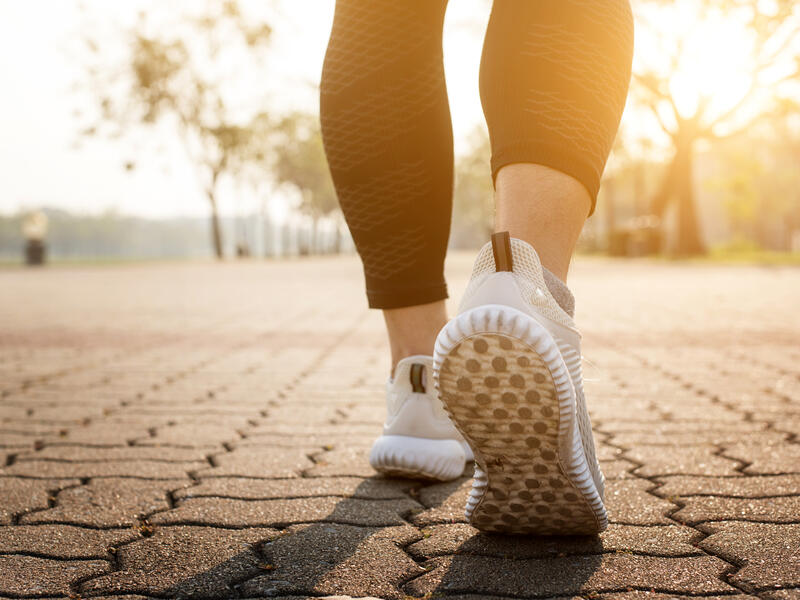Making healthy choices in footwear starts with a proper fit and feel. From there it depends on what you plan to do with your feet.
In many cases, the wrong shoes will eventually tell you this relationship isn’t set up for the long haul. Shoes will start hurting your feet, or they will make it clear to you in other ways that they are not designed to do what you’re asking of them.
To avoid making choices you will later regret, there are a few things to remember that will make your time on your feet a better part of your day.
“My primary recommendation is to go with a shoe that feels comfortable,” said Burkley Jensen, D.P.M., a podiatrist at Sanford Orthopedics and Sports Medicine in Bismarck, North Dakota. “You are the only person who can really say if a shoe is comfortable or not.”
Using fit and comfort as your cornerstones, there are other considerations that factor into the responsible selection of new shoes.
“Once you’ve found something that is comfortable, make sure it matches the type of activity you are going to be doing,” Dr. Jensen said. “Certainly if you are going to be doing a lot of walking or exercise you need to find a shoe that matches that activity. In general, finding a shoe with more support, stability and cushion can help with comfort but also prevent foot deformities.”
Ultimately, most foot problems made worse by wearing the wrong shoes can be improved by wearing the right ones. In that sense, a person’s quality of life is connected to how well their shoes fit.
Tips for buying the correct shoes
- It is a good idea to buy shoes at the end of the day when your feet are larger.
- Measure your feet. One is often larger than the other and you want to wear the size that fits the larger foot.
- Try on shoes with socks, hose or special inserts that you usually wear.
- Walk around the store in the shoes you’re interested in before you buy them.
- Sizes vary among shoe brands and styles. Decide on a shoe by how it fits on your foot, not by the marked size.
According to one study published by the Journal of Foot and Ankle Research, more than 60% of people are wearing shoes that do not fit correctly.
We asked Dr. Jensen to tell us how we can improve those numbers:

What are the best shoes for young children?
“It is important for the child to find a shoe that fits properly,” Dr. Jensen said. “Finding a shoe that is more stiff in the back and flexible in the toes while having enough room in the toebox is helpful. Some brands that make supportive children shoes are: Asics, New Balance, Under Armour and Hoka, to name a few.”
“A good fit is about a finger’s width from the end of the shoe to the tip of the big toe,” Dr. Jensen said. “If the shoes are too tight it can cause blisters, calluses and ingrown toe nails.”
It is important for parents to remember that it can be a little more difficult to get feedback from young children. They are going to tell you just about anything feels good on their feet. It is also important to remember that parents need not spend a lot of money in pursuit of suitable shoes for their children.
“If a child is complaining of foot pain or has any specific foot deformities then there would be some specific shoes that a professional may recommend,” Dr. Jensen said.
What are the best shoes for people as they get older?
Dr. Jensen gets a lot of patients who are in their 30s or 40s and they are starting to deal with foot pain. In many instances this is because their feet have changed – but their footwear has not.
“The truth is as we age our foot structure changes,” Dr. Jensen said. “What we used to be able to tolerate we might not be able to tolerate anymore. This may require focusing on wearing shoes that have more arch support or even finding an insole for your shoes. Often a podiatrist can look at your foot type and give a specific category of shoe that might work best.”
A general rule of thumb is that if you have a really high arch, you might want to wear a shoe that has more cushion. If you have flat feet, you may want a shoe that is more rigid and has more arch support and stability.
“There are many shoe brands out there so it is important to try on different styles and types of shoes to see what matches your foot the best. Though there are many other great brands of shoes, some examples of tennis shoe brands that provide good support are Brooks, Asics, New Balance, and Hoka,” Dr. Jensen said. “Typically, these brands are going to have different models for different foot types.”
Let’s say you’re 65 years old and you like getting your steps in every day. What are your best options?
There are several models out there that are specifically branded for walking. Most of them have a “rocker sole” that tapers at the toe and heel and promotes a rocking motion with each step. Walking shoes are also typically going to be a little stiffer in the sole.
“Just because a shoe is branded as a walking shoe doesn’t mean it is the right shoe for you,” Dr. Jensen said. “Many running shoes can also serve as excellent shoes for walking and often times may be a better choice. These shoes typically have more of a mesh material in the toe box that is more breathable.”
What about high heels? Are some choices better than others?
If you’re wearing high heels for special occasions for just a short time, you likely won’t do long-term damage to your feet. If you’re in situations where you need to wear dressier shoes for most of the day, it’s wise to choose comfort over style. Or find a compromise.
Because high heels cause body weight to shift forward, they can pinch toes and contribute to problems with hammertoe, bunions, pinched nerves and ingrown toenails.
“Some good brands include Clarks, Allegria and Danskos,” Dr. Jensen said. “For seniors, Vionic and Naturalizer are good options. There are many other options of dress shoes that would be appropriate for longer standing/walking. For women who plan to be in dress shoes for more than a couple hours in a day, they should wear a shoe that is not pointed in the toe with excessive high heels.”
We all see a lot of advertising for shoes. Are there advertisers’ claims that are too good to be true?
Over the years, many shoe brands – some of them very reputable – have had to deal with class-action suits involving falsehoods in advertising. When the shoe companies failed to produce any scientific research to support what their advertising claimed, they had to pay settlements in the millions of dollars.
It’s best to be skeptical about shoes being capable of medical miracles.
“You can’t take someone else’s word for it,” Dr. Jensen said. “If someone says this shoe cures plantar fasciitis or it helps with arthritis or something like that, make sure before you buy them, try them on and see how they feel on your feet.”
How do you know you’re getting a good fit if you buy your shoes online?
Ideally, choosing new shoes will involve going to a shoe store and trying on the shoe. After walking around in them you can decide whether or not you want to buy them. That’s harder to do if you are just shopping online. Many online shoe outlets have generous return policies, but it’s still going to be more difficult to buy shoes online than it would be to buy towels, toys or computers.
“I usually recommend if you want to buy your shoes online, see if you can go to a shoe store and try on that style,” Dr. Jensen said. “A lot of shoes bought online come with free returns so you can send them back if they don’t feel right. A good return policy is important when you’re buying shoes. I have a lot of patients come in who have spent hundreds of dollars online on shoes that don’t feel comfortable.”
If you think you should be wearing insoles (inserts) in your shoes, what is your first step?
Insoles, also known as inserts, can often help solve problems with your shoes. Places like Sanford Health Equip can provide options that can improve your overall health while also making your walks more comfortable.
“Representatives at shoe stores are often familiar with the different arch supports and they often have some general understanding of the mechanics of the feet,” Dr. Jensen said. “They can give you some direction on when that would be appropriate. Ultimately, seeing a podiatrist is really helpful if inserts are something you need. In those cases, we typically would recommend either an over-the-counter or custom-made insert/orthotic.”
Why are shoes an important part of your health?
It’s simple advice, but worth remembering: Wear the appropriate shoe for the occasion. If you’re a jogger, wear jogging shoes. If you’re walking a lot, find a shoe designed for walking.
“The wrong shoes can lead to bunions, hammertoes, plantar fasciitis – a lot of foot pathologies,” Dr. Jensen said. “It is important to match your activities with the right shoe. If you have any concerns with your current foot deformities or pain, then a visit to a podiatrist can help in getting some guidance on whether your shoes are playing a part or if they would have a role in fixing the problem.”
Learn more
- The best summer shoes, according to a foot doctor
- When your shoes might be to blame for pain
- Should your baby wear shoes?
…
Posted In Bismarck, Orthopedics, Sports Medicine
